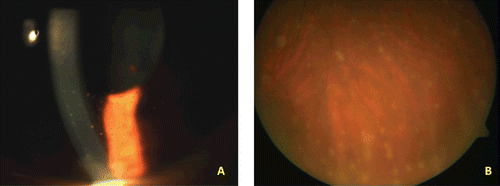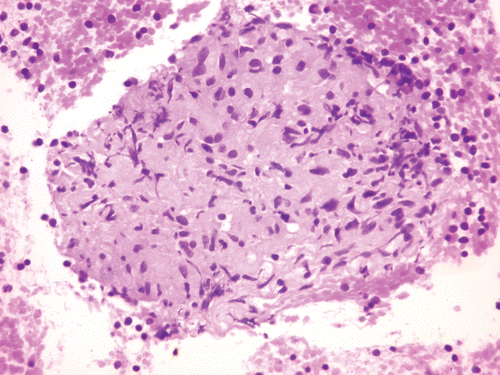Abstract
Purpose: To describe a case of sarcoid uveitis subsequent to anti-TNFα therapy and review previously reported cases.
Methods: Review of the clinical records of the authors’ patient and of the literature using the PubMed database.
Results: A 30-year-old woman presented with intermediate uveitis with snowballs in both eyes. She was on treatment with etanercept due to psoriatic arthritis. An ultrasound-guided biopsy of a mediastinal adenopathy showed non-necrotizing granulomas compatible with sarcoidosis. The clinical picture resolved after etanercept was withdrawn and treatment with immunosuppressants. In a literature search the authors identified six other cases of sarcoid uveitis induced by anti-TNFα therapy. The types of uveitis were anterior uveitis, posterior uveitis, or panuveitis. Management consisted of withdrawal of anti-TNFα therapy and administration of immunosuppressive agents in 5 cases.
Conclusions: Sarcoid uveitis induced by TNFα antagonists is a rare complication. Appropriate management consists of withdrawing the TNFα antagonist and giving immunosuppressants.
Several complications have been associated with the use of anti-tumor necrosis factor α (anti-TNFα) therapy, including an increased risk of infections, reactivation of latent tuberculosis, malignancies, cardiovascular diseases, and the development of autoimmune or autoinflammatory diseases, such as multiple sclerosis, systemic lupus erythematosus, and sarcoidosis.Citation1 Uveitis has also been described as a complication of treatment with anti-TNFα therapy, specifically with etanercept.Citation2 We describe the case of a woman with psoriatic arthritis who developed sarcoid-like granulomatosis and intermediate uveitis while under treatment with etanercept.
MATERIALS AND METHODS
In addition to the case presented, we performed a PubMed search with the following keywords: “infliximab,” “adalimumab,” “etanercept,” and “anti-TNFα” joined by the Boolean operator “OR.” This search was subsequently combined with the entry term “sarcoidosis” by the Boolean operator “AND.” No start date was used for the search and it was performed up to January 2011. An additional search through the references cited in the retrieved articles was also performed. We evaluated all papers found that reported cases of sarcoid-like granulomatosis attributed to anti-TNFα in which uveitis was one of the clinical features of the disease.
RESULTS
A 30-year-old woman sought treatment for fever, fatigue, headache, decreased visual acuity, and floaters of 1 month duration. Her medical history was notable in that it included treatment with etanercept over the previous 4 years for psoriatic arthritis. Previous examinations performed during those years (including chest x- ray imaging, ophthalmological and dermatological assessments) had excluded other systemic autoimmune or autoinflammatory diseases. On admission her visual acuity was 20/20 in both eyes (Snellen charts). Biomicroscopy showed bilateral granulomatous anterior uveitis (). Intraocular pressure was 14 mmHg in both eyes. Funduscopy showed vitritis +1 (Nussenblatt grade), snowballs in the inferior vitreous cavity, and inferior periphlebitis (). Notable findings in ancillary testing were Mantoux test with booster reaction of 16 mm, erythrocyte sedimentation rate of 40 mm/s, and level of angiotensin-converting enzyme (ACE) of 68 U/L. Computed tomography of the chest revealed bilateral hilar and mediastinal adenopathies. shows results of other tests performed. An ultrasound-guided transbronchial biopsy of one of the mediastinal adenopathies revealed non-necrotizing granulomas compatible with sarcoidosis (). A polymerase chain reaction of the harvested tissue was negative for Mycobacterium tuberculosis, as were cultures. No atypical cells were observed in the sample. A diagnosis of sarcoid-like granulomatosis was established. The administration of etanercept was discontinued and treatment with oral prednisone and methotrexate as well as prednisolone drops was started. During follow-up, both uveitis and adenopathies completely resolved. However, the psoriasis worsened, so ustekinumab was added to methotrexate and steroids to control cutaneous disease. At the 8th month of follow-up, eyes were quiet and the psoriasis was under control.
FIGURE 1 A: Biomicroscopy of left eye showing anterior granulomatous uveitis. B: Funduscopy of left eye showing snow-balls in the inferior vitreous cavity.

FIGURE 2 Non-caseating granuloma mainly composed of epithelioid cells with scattered lymphocytes in ultrasound-guided transbronchial biopsy of mediastinal adenopathy (Cell block; Hematoxylin and eosin stain; X400).

TABLE 1 Results of ancillary testing not contributory to etiological diagnosis.
DISCUSSION
Our patient presented with anterior granulomatous uveitis and intermediate uveitis together with hilar and mediastinal adenopathies. Pathological analysis of lymph nodes disclosed non-necrotizing granulomas and ACE levels were elevated, hence we suspected that our patient was suffering from sarcoid-like granulomatosis secondary to etanercept. Ancillary tests ruled out other possible etiologies, including tuberculosis, multiple sclerosis, syphilis, Lyme disease, and lymphoma. Uveitis secondary to psoriatic arthritis was another possible etiology that we considered since inflammation posterior to the lens has been described in patients with psoriatic arthritis–uveitis.Citation3 Nonetheless, this type of uveitis is typically anterior and nongranulomatous. Moreover, our patient presented with a typical acute clinical picture of sarcoidosis. Hence, psoriatic arthritis as a cause of uveitis was considered unlikely.
Sarcoid-like granulomatosis secondary to anti-TNFα therapy has been described previously.Citation1,Citation4 It has been estimated that this adverse event occurs in 0.04% of cases.Citation5 From a review of the medical literature, we identified 6 cases of sarcoidosis presenting with uveitis occurring during anti-TNFα therapy.Citation5–10 The anti-TNFα drug administered was etanercept in 5 of these cases and infliximab in 1. Three patients had rheumatoid arthritis, 2 had ankylosing spondylitis, and 1 had juvenile idiopathic arthritis. The delay between the introduction of anti-TNFα drugs and onset of symptoms ranged between 3 weeks and 69 months. Nonocular findings related to the sarcoidosis were intrathoracic adenopathies (5 cases), extrathoracic adenopathies (2 cases), lung infliltrates (2 cases), parotid glands involvement (2 cases), pulmonary nodules (1 case), hepatitis (2 cases), erythema nodosum (1 case), subcutaneous nodules (1 case), and submandibular sialadenitis (1 case). The types of uveitis were anterior uveitis (2 cases), posterior uveitis (1 case), panuveitis (1 case), anterior uveitis plus retinal periphlebitis (1 case), and anterior uveitis plus chorioretinitis and periphlebitis (1 case). According to the International Criteria for the Diagnosis of Ocular Sarcoidosis,Citation11 a definite diagnosis was reached in 5 of the cases. In 1 patient the diagnosis was presumed ocular sarcoidosis. Clinical management consisted of discontinuation of anti-TNFα therapy plus addition of immunosuppressants in 5 cases, while 1 patient was managed with the addition of steroids without discontinuation of etanercept and switching to adalimumab due to systemic relapse. Progression was favorable, with resolution of ocular and systemic disease in all cases. lists more detailed data concerning each case.
TABLE 2 Clinical features of patients who developed uveitis and sarcoid-like granulomatosis while on anti-TNFα therapy: review of the literature.
Our case is unique, since intermediate uveitis with snowballs has not previously been described in patients with sarcoid uveitis secondary to anti-TNFα therapy. Regarding the general clinical characteristics, our patient is similar to other reported cases: she had articular disease, the delay between introduction of anti-TNFα therapy and the onset of symptoms was 48 months (up to 69 months of delay has been reported), lymph nodes of the thoracic cavity were enlarged, she was on treatment with etanercept (which is the anti-TNFα agent most commonly responsible for drug-induced sarcoid uveitis), and progression was favorable after withdrawal of etanercept and introduction of immunosuppresors.
The pathogenesis of anti-TNFα induced-sarcoidosis is not completely understood. On the other hand, etanercept has greater tendency to induce this complication than infliximab or adalimumab, which may be explained by differences between the two classes of anti-TNFα in terms of both kinetics and mechanisms of action. Both infliximab and adalimumab bind effectively to the soluble and transmembrane forms of TNFα, whereas etanercept forms less stable bonds with TNFα, particularly the transmembrane form.Citation12 Moreover, both monoclonal antibodies were reported to induce cytolisis in contrast to etanercept, which did not.Citation13 Hence, the partial TNFα neutralization by etanercept may enable a redistribution of bioavailable TNFα to sites of lower concentration (including the eyes), where it could promote the formation of granulomatous inflammation.Citation4 Furthermore, it is well known that TNFα may have immunosuppressive effects: long-term exposure to this cytokine can directly prevent the activation of T cellsCitation14,Citation15 and promote the expansion of Treg cells;Citation16 repeated administration of TNFα has been shown to protect Lewis rats from developing lupus-like nephritisCitation17,Citation18 and autoimmune arthritis and more severe experimental autoimmune encephalomyelitis and collagen-induced arthritis is induced in TNFα-deficient mice.Citation19,Citation20,Citation21 Hence, it could be argued that in a particular subset of patients anti-TNFα therapy may give rise to increased activation of T cells, promoting the development of inflammatory processes.
In summary, uveitis may be one of the clinical features of sarcoid-like granulomatosis induced by anti-TNFα therapy. We report a new case of sarcoid uveitis that occurred during treatment with a TNFα blocking agent in which the type of uveitis, intermediate uveitis with snowballs, had not been previously described. Etanercept is the anti-TNFα agent most commonly reported to be associated with sarcoid uveitis induced by these drugs. Prognosis seems to be good, since in all reported cases in the literature, intraocular inflammation has completely resolved after withdrawal of anti-TNFα therapy and/or adding immunosuppressants. Further research is needed to understand the pathogenesis of sarcoid-like granulomatosis induced by these drugs.
Declaration of interest:: The authors report no conflicts of interest. The authors alone are responsible for the content and writing of the paper.
REFERENCES
- Ramos-Casals M, Perez-Alvarez R, Diaz Lagares C, et al.; The BIOGEAS Study Group. Autoimmune diseases induced by biological agents: a double-edged sword? Autoimmune Rev. 2010;9:188–193.
- Kakkassery V, Mergler S, Pleyer U. Anti-TNF-alpha treatment: a possible promoter in endogenous uveitis? observational report on six patients: occurrence of uveitis following etanercept treatment. Curr Eye Res. 2010; 35: 751–756
- Paiva ES, Macaluso DC, Edwards A, et al. Characterisation of uveitis in patients with psoriatic arthritis. Ann Rheum Dis. 2000;59:67–70
- Massara A, Cavazzini L, La Corte R. Sarcoidosis appearing during anti-tumor necrosis factor α therapy: a new “class effect” paradoxical phenomenon. Two case reports and review of the literature. Semin Arthritis Rheum. 2010; 39:313–319
- Daïen CI, Monnier A, Claudepierre P, et al. for the Club Rheumatismes et Inflammation (CRI). Sarcoid-like granulomatosis in patients treated with tumor necrosis factor blockers: 10 cases. Rheumatology. 2009;48:883–886
- Hashkes PJ, Shajrawi I. Sarcoid-related uveitis occurring during etanercept therapy. Clin Exp Rheumatol. 2003;21:645–646
- Sturferlt G, Christensson B, Bynke G, et al. Neurosarcoidosis in a patient with rheumatoid arthritis during treatment with infliximab. J Rheumatol. 2007;34:2313–2314
- Louie GH, Chitkara P, Ward MM. Relapse of sarcoidosis upon treatment with etanercept. Ann Rheum Dis. 2008;67: 896–898
- Suzuki J, Goto H. Uveitis associated with sarcoidosis exacerbated by etanercept. Jpn J Ophthalmol. 2009;53:433–444
- Skoie IM, Wildhagen K, Omdal R. Development of sarcoidosis following etanercept treatment: a report of three cases. Rheumatol Int. 2010 [Epub ahead of print].
- Wakefield D, Zierhut M. Controversy: ocular sarcoidosis. Ocul Immunol Inflamm. 2010;18:5–9
- Imrie FR, Dick A. Biologics in the treatment of uveitis. Curr Opin Ophthalmol. 2007;18:481–486
- Mitoma H, Horiuchi T, Tsukamoto H, et al. Mechanisms of cytotoxic effects of anti-tumor necrosis factor agents on transmembrane tumor necrosis factor alpha-expressing cells: comparison among infliximab, etanercept and adalimumab. Arthritis Rheum. 2008;58:1248–1257
- Cope AP, Londei M, Chu NR, et al. Chronic exposure to tumor necrosis factor (TNF) in vitro impairs the activation of T cells through the T cell receptor/CD3 complex: reversal in vivo by anti-TNF antibodies in patients with rheumatoid arthritis. J Clin Invest. 1994;94:749–760.
- Cope AP, Liblau RS, Yang XD, et al. Chronic tumor necrosis factor alters T cell responses by attenuating T cell receptor signaling. J Exp Med. 1997;185:1573–1584
- Chen X, Bäumel M, Männel DN, et al. Interaction of TNF with TNF receptor type 2 promotes expansion and function of mouse CD4+CD25+ T regulatory cells. J Immunol. 2007; 179:154–161.
- Jacob CO, McDevitt HO. Tumour necrosis factor-alpha in murine autoimmune ‘lupus’ nephritis. Nature. 1998;331: 356–358
- Gordon C, Ranges GE, Greenspan JS, et al. Chronic therapy with recombinant tumor necrosis factor-alpha in autoimmune NZB/NZW F1 mice. Clin Immunol Immunopathol. 1989; 52:421–434.
- Qin HY, Chaturvedi P, Singh B. In vivo apoptosis of diabetogenic T cells in NOD mice by IFN-gamma/TNF-alpha. Int Immunol. 2004;16:1723–1732
- Kim EY, Chi HH, Rajaiah R, et al. Exogenous tumour necrosis factor alpha induces suppression of autoimmune arthritis. Arthritis Res Ther. 2008;10: R38
- Cope AP. Regulation of autoimmunity by proinflammatory cytokines. Curr Opin Immunol. 1998;10:669–676